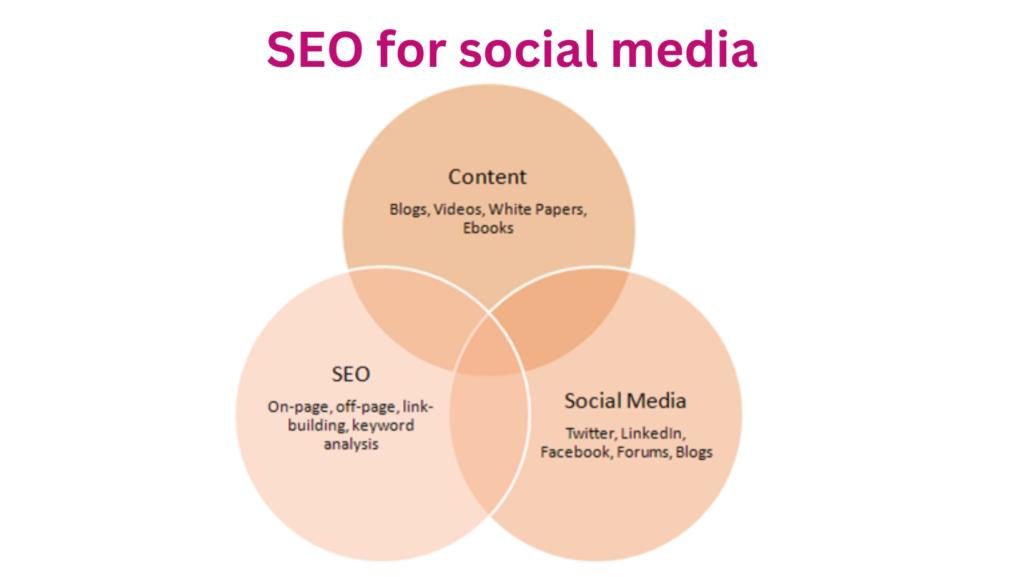Improve SEO Results : 05 Social Media Techniques
Social networking can improve your website’s SEO effectiveness and improve your Google search ranking. This post explains 5 social media tactics to help improve SEO results.
Introduction
You already know what Search Engine Optimization (SEO) is. Simply, improving search engine traffic, quantitatively and qualitatively, related to a certain website or web page is called SEO. SEO is used as a digital marketing strategy. It takes into account the various data that people enter into browsers to search for something and finds what suits them best.
In particular, many marketers continue to separate social media marketing from search engine optimization as separate ecosystems. But in our view, social media marketing is an effective SEO partner, so they should work together. This will give you the knowledge of five social media tactics to improve SEO results.
How does social media affect a website’s SEO?
The first thing to understand is that social media does not instantly improve search rankings. There is a reason to say so.
In 2010, the head of Google’s web spam team stated in a video that they use links from Twitter and Facebook for all of their web search rankings. But about four years after that, he released another video saying that social signals like Facebook likes and Twitter follows have little impact on search engine results.
You will see that these are two contradictory statements. He explained that Google searches the Internet to get a current baseline picture for information. However, social media only gives partial signals because they are always changing. So his statement must be accepted as correct as it cannot give a complete picture. Moreover, many other surveys have been presented confirming this opinion.
Correlation of social media SEO and a website
But these studies revealed that as more people share information on social media, social signals are created that show your posts are useful to your target audience. So links to social media are useful for SEO. It happens not directly but indirectly.
High shares and high ratings on specific social media platforms have been linked in several studies, however correlation does not imply causation, that is the problem.
Any correlation is often a sign that a website is doing a good job of creating high-quality content that appeals to consumers on social media and organic search traffic channels.
It is challenging for search engines to determine the authentic identity and authority of social accounts, which limits their ability to determine the importance of a link.
We know that Google does not equate a Facebook share to a backlink from an authoritative website. However, social media has indirect but still significant effects on SEO. Now let’s see how it happens.
- Dissemination of original, thought provoking and educational information.
- Content shared and linked through social media
- Website traffic increases when followers join social media profiles.
- It expands a brand’s community.
- Credible SEO and consistent social media interactions strengthen brand reputation.
- Websites with higher search engine rankings.
- Users find a website naturally through search engines.
The combination of all these advantages will significantly affect your SEO ranking.
5 Social Media Tactics To improve SEO Results That Help Marketing Campaigns With Organic Searches
Here are five strategies to make social media directly impact your brand’s search rankings.
- Create Opportunities for Links
- Increase engagement and content life
- Increase brand recognition and favorable mentions
- Build partnerships to improve SEO results
- Create Authority
01) Create Opportunities for Links

Simply said, you are depending on social media to spread the word about your content and let people know that it is available. It’s amazing how much excellent information get little to no advertising while being plainly well-researched and produced over a long period of time. Marketing your content is a passive technique to generate link chances.
Facts to remember
- To promote your content, develop a social media marketing strategy.
- Create a Standard Operating Procedure (SOP) to make sure the sharing strategy is applied to each new piece of content.
- Frequently distribute evergreen material by keeping a list of it updated.
- Just keep in mind that just a small part of your prospective audience will see your content on social media, so a single sharing won’t get to everyone who follows you.
02) Increase engagement and content life

Even if you create and publish great content, if no one can find it, you won’t get what you want. Sharing on social media networks can extend the shelf life of the content, as people can find your material and brand while sharing and distributing the content.
The first technique in this situation is to ensure that your material is tasty. A purpose and connection with the audience are prerequisites for content. They are:
- Give an answer to a question.
- Engage someone’s interest in some way.
- Teach someone a subject that interests them.
- Make an emotional connection with someone.
- Really great content can be categorized in several ways.
Keep track of your audience’s reactions. You’ll find plenty of social media analytics tools to help you figure out what topics and types of content are trending on both the platform and external websites.
When you have interesting content and the first box is checked, you need to start working on your social media strategy to get that content in front of your audience. The more relevant the content the stronger your chances of getting likes, comments, shares and tags to keep the momentum going.
Do it by being proactive and using strategies like identifying influencers and business partners, choosing relevant hashtags, offering content and rewards to thank followers for their participation.
When you combine the right content with an effective social media marketing plan you can significantly increase the reach and shelf life of your content.
Re-sharing on social media to keep content up to date can give it a significant boost and extend the life of your content so it performs well.
Facts to Remember
- Sharing material on social media increases its discoverability and extends its lifespan as more people share it over time.
- Your social media strategy, content strategy and analytics should all be coordinated. You need to put out interesting content that people want to discuss and share.
- To extend the life of high-performing old content, it needs to be refreshed and distributed.
03) Increase brand recognition and favorable mentions

According to Google’s Search Quality Evaluation Guidelines document, human raters consider brand mentions when determining a website’s trustworthiness.
This is where social media can have a significant impact on how people perceive your brand as a whole. Consumers are significantly more satisfied with businesses that have and interact with active social media profiles.
For example, businesses using Twitter reported a 19% increase in average customer satisfaction.
This usually affects the sensitivity of brand mentions, especially in user reviews and public forums. When deciding what to rank you for, Google takes into account the context of your online activity and how people talk about you.
Based on a number of variables, Google analyzes Internet references to classify you as relevant or irrelevant to search queries. Social media is a great way to keep good brand mentions, which is something you want to achieve.
Facts to Remember
- Find strategies to promote favorable brand mentions on social media and elsewhere.
- Develop a social media following of die-hard brand advocates.
- Depending on your goal, adjust your messaging on different social media platforms for best success.
04) Build partnerships to improve SEO results

Pay a special attention to developing online relationships that can lead to collaboration. While it may be increasingly difficult to engage an audience organically on social media, you can get results with consistent effort.
Despite various difficulties, these platforms still excel in their original purpose, which is to connect people and encourage connections. In this regard, you should focus on the following three areas of relationship development:
- Brand advocates are social media users who support your business and spread the word about you at no additional charge, increasing your reach and effectiveness.
- Organic influencers are social media accounts that actually have the E-A-T formula (expertise, authority and credibility) in your business, as opposed to paid influencers to do so. Any glowing recommendation about your company, products or services will be greatly appreciated by their attentive viewers.
- Strategic partners are companies or influencers who are not in direct competition with you and are willing to work together to co-create great content that appeals to both of your audiences and offers potential for cross-promotional marketing.
It may take you several years to develop a successful partnership. For that you have to deal with the other party with patience and cooperation. When you appreciate and share the other party’s posts, they will begin to do the same.
There you can get various good opportunities. A good trick to help your articles get good demand and increase the number of readers and shares. This is how cultivating positive relationships on social media can open doors to opportunities that weren’t there before to increase your reach.
Facts to Remember
- Spend more time on social media cultivating relationships at the three levels we discussed earlier.
- List the accounts you want to focus on for relationship building. Maintain the accuracy of this list and make sure to regularly monitor each account.
- Don’t just keep clicking the “like” button. Make an attempt to interact with others. Post feedback, respond to queries, and, if applicable, provide remarks.
05) To improve your SEO Results, Create Authority
SEO, content marketing, and social media all work together. One of the main advantages of content marketing is that, if you continually post high-quality content, you eventually recognize as an authority in your industry.

People start to believe the facts you offer, and as a result, they begin to believe in your entire brand. That’s good news because Google’s assessment of the authority and reliability of your website is crucial to your search ranking success.
With social media acting as a megaphone, you can now expand your total reach, increase your brand’s visibility, and make your content more discoverable by pushing it to other channels. There is a reason for saying so. Every day, people use a wide range of resources, which is why omnichannel marketing is such a powerful tool to connect with consumers wherever they are.
This benefits other mediums like shared content, word of mouth advertising, client reviews, fresh prospects, open forums, organic site traffic and the list goes on. But social media shouldn’t be the primary source of authority you work to build around your brand.
It is essential that you have your own domain. Remember that using social media or using a free website (helpers like WordPress, Joomla) to build your authority puts your content out of your control. If those sites ever go down, you’ll lose all your content and the authority you’ve built up.
Your social media platforms should drive traffic back to your website in addition to acting as independent brand awareness funnels. Secondary content distribution channels include tweets, guest blogs, podcast features on LinkedIn, Facebook, YouTube and other websites.
Facts to Remember
- If you don’t already have a domain, you should purchase one so you can establish your authority.
- Social media, SEO, and content marketing are all interconnected, so treat them as a whole. Accordingly, plan to integrate everything into your marketing approach. To drive traffic back to your main authority website
Use the aforementioned auxiliary channels. - Pay more attention to how you use social media. Use analytics and other tools to select the times (days and hours) that have the greatest impact.
Recommended :


